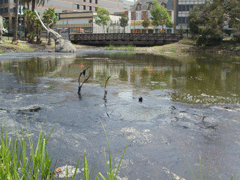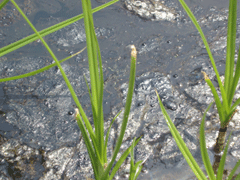Emerging Science Note/La Brea Tar Pits
Air Date: Week of May 25, 2007

Methane bubbles reveal signs of life in the asphalt of La Brea Tar Pits in Los Angeles, California. (Photo: Ingrid Lobet)
Living on Earth’s Meghan Vigeant reports on bacteria discovered in tar pits that could be used to break down oil in the environment.
Transcript
[SOUND OF TAR PIT BUBBLES]
VIGEANT: It’s alive! And it’s living in the toxic soup of Rancho La Brea Tar Pits in the heart of Los Angeles
The tar pits have long attracted tourists for the Ice Age fossils found there, things like mammoths and saber-toothed cats, but the most recent finds weren’t fossils. They’re very much alive. 200 new species and even some whole new families of bacteria have been discovered living in the bubbling pits.
[SCIENCE NOTE THEME]
VIGEANT: Calling it The La Brea Tar Pits actually is a little misleading and kind of redundant, since La Brea means “the tar” in Spanish, which makes it “The The Tar Tar pits”. And it turns out that the stuff in the tar pits actually isn’t tar, it’s asphalt that seeped up from petroleum deposits and formed hundreds of sticky pools

Methane bubbles reveal signs of life in the asphalt of La Brea Tar Pits in Los Angeles, California. (Photo: Ingrid Lobet)
The bacteria are living in extreme conditions; no oxygen, very little water and a soup of toxic chemicals. The researchers have also found that some of the new bacteria can survive in highly saline and radioactive environments. This hardiness and their appetite for the petroleum goop of the tar pits means they may be useful for such applications as cleaning chemical spills and oil recovery. For now their dinner is served at The La Brea Tar Pits.
[SOUND OF TAR PIT BUBBLE]
VIGEANT: Oh, excuse me. That’s this weeks note on emerging science I’m Meghan Vigeant.
Living on Earth wants to hear from you!
Living on Earth
62 Calef Highway, Suite 212
Lee, NH 03861
Telephone: 617-287-4121
E-mail: comments@loe.org
Newsletter [Click here]
Donate to Living on Earth!
Living on Earth is an independent media program and relies entirely on contributions from listeners and institutions supporting public service. Please donate now to preserve an independent environmental voice.
NewsletterLiving on Earth offers a weekly delivery of the show's rundown to your mailbox. Sign up for our newsletter today!
 Sailors For The Sea: Be the change you want to sea.
Sailors For The Sea: Be the change you want to sea.
 The Grantham Foundation for the Protection of the Environment: Committed to protecting and improving the health of the global environment.
The Grantham Foundation for the Protection of the Environment: Committed to protecting and improving the health of the global environment.
 Contribute to Living on Earth and receive, as our gift to you, an archival print of one of Mark Seth Lender's extraordinary wildlife photographs. Follow the link to see Mark's current collection of photographs.
Contribute to Living on Earth and receive, as our gift to you, an archival print of one of Mark Seth Lender's extraordinary wildlife photographs. Follow the link to see Mark's current collection of photographs.
 Buy a signed copy of Mark Seth Lender's book Smeagull the Seagull & support Living on Earth
Buy a signed copy of Mark Seth Lender's book Smeagull the Seagull & support Living on Earth

